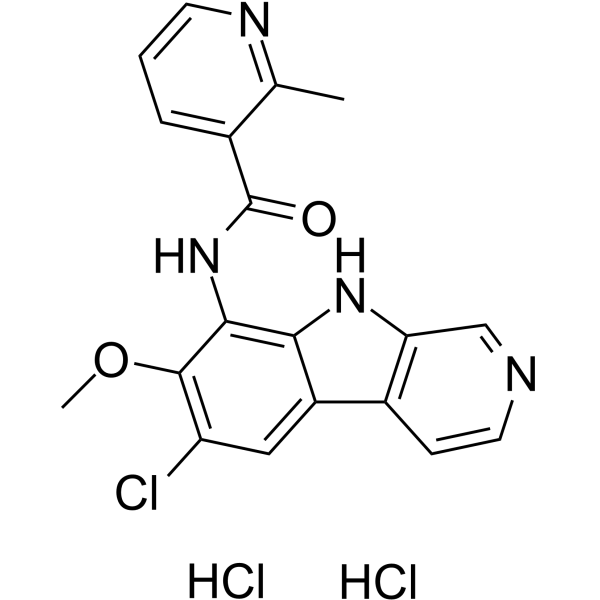MLN120B dihydrochloride (Synonyms: ML120B dihydrochloride) |
| Catalog No.GC66019 |
El diclorhidrato de MLN120B (diclorhidrato de ML120B) es un inhibidor potente, competitivo con ATP y activo por vÍa oral de IKKβ con un IC50 de 60 nM. MLN120B inhibe el crecimiento de células de mieloma mÚltiple in vitro e in vivo y también se puede utilizar para la investigaciÓn de la artritis reumatoide.
Products are for research use only. Not for human use. We do not sell to patients.

Cas No.: 1782573-78-7
Sample solution is provided at 25 µL, 10mM.
MLN120B dihydrochloride (ML120B dihydrochloride) is a potent, ATP competitive, and orally active inhibitor of IKKβ with an IC50 of 60 nM. MLN120B inhibits multiple myeloma cell growth in vitro and in vivo and also can be used for the research of rheumatoid arthritis[1][2].
MLB120B (0-20 μM; 90 minutes) inhibits phosphorylation and degradation of IκB in RPMI 8226 and INA6 cells; however, no significant inhibition is observed in MM.1S cells[1].
MLB120B (1.25-20 μM; 90 minutes) completely abrogates TNF-a-induced phosphorylation and degradation of IκB in a dosedependent fashion. Phosphorylation of p65 NF-κB induced by TNF-a is also blocked by MLN120B[1].
MLN120B inhibits proliferation of multiple myeloma cell lines. MM.1S, MM.1R, RPMI 8226, RPMI-LR5, RPMI-Dox40, U266, and INA6 cells. Five percent to fifty percent and 18% to 70% inhibition in proliferation is observed at doses >20 uM and [3H]thymidine uptake, respectively[1].
MLN120B (1.25-40 μM; 72 hours) almost completely blocks stimulation of MM.1S, U266, and INA6 cell growth, as well as IL-6 secretion from BMSCs, induced by multiple myeloma cell adherence to BMSCs[1].
MLN120B shows an inhibitory effect on LPS induced NF-κB activation in RAW267.4 cells. The IC50 values of MLN120B is 1.4 µM, 14.8 µM or 27.3 µM for NF-κB2-luc2, IL8-luc2 or TNF-AIP3-luc2 reporter transfected cells, respectively[3].
Western Blot Analysis[1]
| Cell Line: | MM.1S cells |
| Concentration: | 5 μM; 10 μM; 20 μM |
| Incubation Time: | 90 mintues |
| Result: | Inhibited p-IκB and p-P65 expression in a dose-dependent manner. |
Cell Viability Assay[1]
| Cell Line: | Myeloma cell lines: MM.1S, MM.1R, RPMI 8226, RPMI-LR5, RPMI-Dox40, U266, and INA6 cells |
| Concentration: | 0-40 μM |
| Incubation Time: | 72 hours |
| Result: | Inhibited proliferation of multiple myeloma cell lines. |
MLN120B (oral administration; 50 mg/kg; twice daily; 3 weeks) induces a reduction of shuIL-6R, marker of tumor growth, marker of tumor growth. It also leads to a rend toward prolonged survival in animals treated versus control[1].
MLN120B (oral administration; 50 mg/kg; twice daily; 3 weeks) induces a reduction of shuIL-6R, marker of tumor growth, marker of tumor growth. It also leads to a rend toward prolonged survival in animals treated versus control[3].
| Animal Model: | SCID mice implanted with human fetal bone chips and then INA6 cells are directly injected into mice[1] |
| Dosage: | 50 mg/kg |
| Administration: | Oral administration; twice daily; 3 weeks |
| Result: | Inhibited human multiple myeloma cell growth in vivo. |
| Animal Model: | Two-month-old female Lewis rats[2] |
| Dosage: | 30 mg/kg, 10 mg/kg, 3 mg/kg, or 1 mg/kg |
| Administration: | Oral administration; twice daily; 3 weeks |
| Result: | Protected against bone and cartilage destruction in a rat model. |
Average Rating: 5 (Based on Reviews and 30 reference(s) in Google Scholar.)
GLPBIO products are for RESEARCH USE ONLY. Please make sure your review or question is research based.
Required fields are marked with *




















